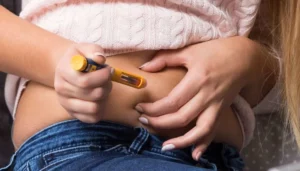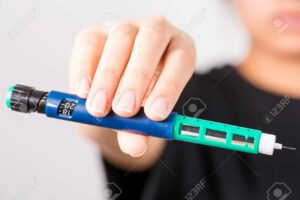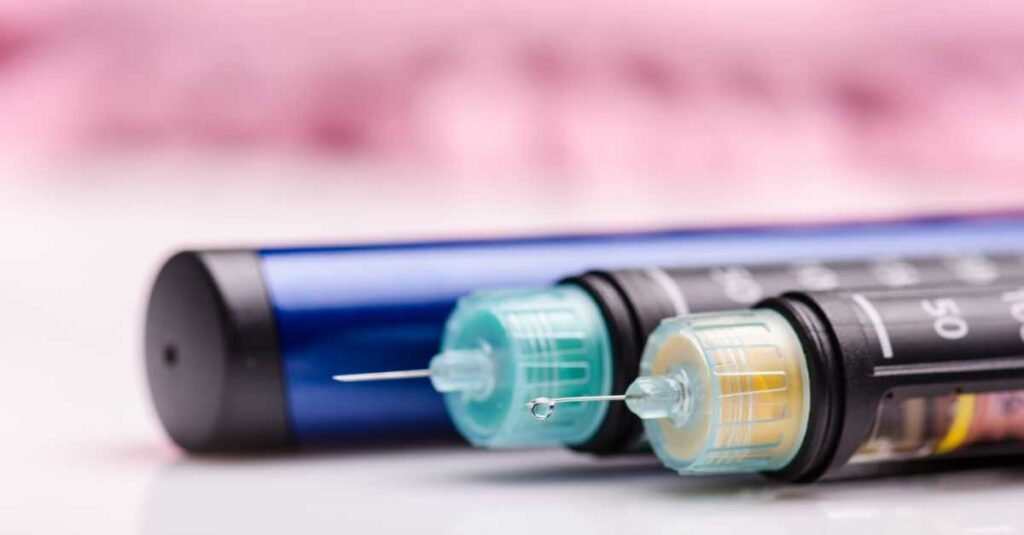Living with diabetes often requires individuals to incorporate insulin injections into their daily routine. The advent of insulin injection pens has revolutionized diabetes management, providing a convenient and user-friendly alternative to traditional syringes. In this blog, we will explore the ins and outs of insulin injection pens, offering valuable insights, tips, and step-by-step guidance to help you navigate this essential aspect of diabetes care with confidence.
Contents
Are Insulin Pens Better Than Injections?
 Insulin pens and traditional injections both serve the critical purpose of delivering insulin to manage diabetes. But the choice between them often comes down to individual preferences and lifestyle considerations. Insulin pens offer several advantages that make them a preferred choice for many individuals. The pens eliminate the need for carrying vials, syringes, and separate needles, streamlining the injection process.
Insulin pens and traditional injections both serve the critical purpose of delivering insulin to manage diabetes. But the choice between them often comes down to individual preferences and lifestyle considerations. Insulin pens offer several advantages that make them a preferred choice for many individuals. The pens eliminate the need for carrying vials, syringes, and separate needles, streamlining the injection process.
Additionally, insulin pens often come pre-filled, allowing for precise dosage delivery without the need for manual measurements. This not only reduces the margin for error but also simplifies the overall administration process. Ultimately, making it more accessible for individuals who may have dexterity challenges or vision impairments.
However, it’s essential to note that the choice between insulin pens and injections depends on various factors. Some individuals may still prefer the familiarity and flexibility of traditional injections. Especially if they require customized dosage adjustments or use a combination of different insulins.
What Is The Best Insulin Injection Pen For Type 2 Diabetes?
Determining the “best” insulin injection pen for type 2 diabetes can depend on various factors, including individual preferences, lifestyle, and the specific insulin regimen prescribed by a healthcare professional. There are several insulin pen options available on the market, each with its features. Here are a few popular insulin pens commonly used for type 2 diabetes:
NovoPen Echo
The NovoPen Echo, developed by Novo Nordisk, stands out as a reliable and user-friendly insulin pen for individuals with type 2 diabetes. One of its notable features is the ability to deliver half-unit doses, allowing for precise adjustments in insulin dosage. This is particularly beneficial for patients who require fine-tuned control over their insulin intake.
NovoPen Echo is compatible with a variety of Novo Nordisk insulin formulations, offering versatility in treatment options. Its durable design ensures long-term use, and the pen’s straightforward dosing mechanism makes it accessible to users of varying experience levels.
Humalog KwikPen and Humulin Pen
Manufactured by Eli Lilly, the Humalog KwikPen and Humulin Pen are popular choices for individuals managing type 2 diabetes. These pens come pre-filled with insulin cartridges, simplifying the injection process. Both pens offer the advantage of half-unit dosing, providing flexibility for patients who require more precise adjustments in their insulin intake. Eli Lilly’s commitment to innovation is reflected in these pens, making them convenient and efficient tools for administering Humalog and Humulin insulins.
Lantus SoloSTAR
Produced by Sanofi, the Lantus SoloSTAR is a disposable insulin pen designed for use with Lantus (insulin glargine), a long-acting insulin. Its simplicity and user-friendly design make it an attractive option for individuals with type 2 diabetes requiring basal insulin. The pre-filled SoloSTAR pen eliminates the need for manual cartridge loading, offering convenience and reducing the risk of dosing errors. The pen’s durability and ease of use contribute to its popularity among those seeking a straightforward solution for their diabetes management.
Levemir FlexTouch
Novo Nordisk’s Levemir FlexTouch is a reliable insulin pen designed for use with Levemir (insulin detemir). Its key feature is the FlexTouch dosing mechanism, which makes the injection process simple and user-friendly. The pen allows for precise dosage adjustments, offering flexibility to individuals with varying insulin needs. Like other Novo Nordisk pens, the Levemir FlexTouch is built with durability in mind, ensuring a reliable and consistent insulin delivery system for individuals managing their type 2 diabetes.
In choosing the most suitable insulin pen, individuals should consult with their healthcare providers to consider their specific insulin requirements, lifestyle preferences, and overall treatment goals.
How To Be Prepared For An Insulin Injection Pen?
 Being well-prepared for an insulin injection with an insulin pen is crucial for ensuring a smooth and effective administration. Here’s a step-by-step guide on how to prepare for an insulin injection with a pen:
Being well-prepared for an insulin injection with an insulin pen is crucial for ensuring a smooth and effective administration. Here’s a step-by-step guide on how to prepare for an insulin injection with a pen:
- Gather Supplies
Before starting the injection process, gather all the necessary supplies. This typically includes the insulin pen, a new needle (if applicable, as some pens come with integrated needles), alcohol wipes, and a sharps disposal container.
- Prepare the Injection Site
Choose a clean and suitable injection site, rotating between different areas to prevent tissue damage. Common injection sites include the abdomen, thighs, and upper arms. Clean the chosen site with an alcohol wipe and allow it to air dry.
- Set the Correct Dosage
Dial the dose selector on the insulin pen to the prescribed dosage. Double-check that you have selected the right amount before proceeding.
- Inject the Insulin
Hold the insulin pen at a 90-degree angle to the injection site or at the angle recommended by your healthcare provider. Insert the needle into the skin and inject the insulin at a slow, steady pace. After injecting the full dose, count to 10 before removing the needle to ensure that the full amount is delivered.
- Dispose of the Needle Safely
Safely dispose of the used needle in a sharps disposal container. Do not recap the needle, as it may lead to accidental needle sticks.
- Record the Injection
Keep a log of your injections, noting the time, date, and dosage administered. This record can help monitor your diabetes management and discuss any concerns with your healthcare provider.
- Store the Insulin Pen Properly
After use, store the insulin pen according to the manufacturer’s guidelines. Some pens may need refrigeration, while others can be stored at room temperature. Proper storage ensures the stability and effectiveness of the insulin.
By following these steps and maintaining good injection practices, you can enhance the safety and effectiveness of your insulin administration with an insulin pen. If you have any questions or concerns, always consult with your healthcare provider for personalized guidance.
What Are The Limitations To Know?
 While insulin pens offer numerous advantages, it’s important to be aware of their limitations to ensure safe and effective use. Here are some key limitations and considerations:
While insulin pens offer numerous advantages, it’s important to be aware of their limitations to ensure safe and effective use. Here are some key limitations and considerations:
Dosage Flexibility
- Limited Half-Unit Dosing: While many insulin pens allow for precise dosing, some may have limitations in terms of dose increments. Not all pens provide half-unit dosing, which could be a drawback for individuals who require very fine adjustments in their insulin dosage.
Needle Length and Gauge
- Fixed Needle Length: Insulin pens typically come with fixed needle lengths, and users cannot change the needle size. This may be a limitation for individuals who have specific preferences or requirements for needle length and gauge.
Insulin Compatibility
- Brand-Specific Compatibility: Insulin pens are often designed for use with specific brands of insulin. It’s crucial to ensure that the pen and insulin type prescribed by your healthcare provider are compatible. Mixing different insulin types in the same pen may lead to inaccurate dosing.
Temperature Sensitivity
- Storage Requirements: Insulin, including that stored in pens, is sensitive to temperature. Some insulin pens require refrigeration, while others can be stored at room temperature. It’s essential to adhere to the manufacturer’s storage guidelines to maintain the stability and efficacy of the insulin.
User Technique
- Proper Injection Technique: Users must be trained in the correct injection technique, including selecting the right injection site, inserting the needle at the correct angle, and ensuring a full dose delivery. Incorrect technique may result in suboptimal insulin absorption and effectiveness.
Device Malfunctions
- Risk of Malfunctions: Insulin pens, like any medical device, can experience malfunctions. Users should be aware of the proper handling and maintenance of the pen to minimize the risk of malfunctions. Regularly check the pen for damage or wear and consult with healthcare providers if issues arise.
Accessibility
- Availability and Cost: The availability and cost of insulin pens may vary depending on geographic location and healthcare systems. Accessibility can be a limiting factor for some individuals, especially in regions with limited resources.
Waste Disposal
- Proper Disposal of Used Pens: Disposing of used insulin pens, including needles, requires adherence to safety guidelines. Users must use designated sharps containers for proper disposal to prevent accidental needle sticks and environmental contamination.
Individual Preferences
- User Preferences: While some individuals prefer the convenience of insulin pens, others may have personal preferences for vials and syringes or other insulin delivery methods. Healthcare providers should consider individual preferences when prescribing insulin.
Overall, it’s essential for individuals using insulin pens to have open communication with their healthcare providers, attend regular check-ups, and receive proper training on the specific pen they are using. By understanding these limitations and addressing them with healthcare professionals, individuals can make informed decisions to optimize their diabetes management.
Conclusion
In conclusion, mastering the use of an insulin injection pen is a crucial step for effective diabetes management. These pens offer convenience, ease of use, and precise dosing, making them valuable tools for individuals with type 2 diabetes. From understanding the different types of pens to proper injection techniques and troubleshooting common challenges, this comprehensive guide empowers users to navigate the world of insulin pens with confidence.
Remember, open communication with healthcare providers, regular monitoring, and adherence to proper storage and disposal guidelines are key elements in ensuring the success of insulin pen use. By incorporating these practices into your routine, you can take control of your diabetes journey and enhance the overall effectiveness of your insulin therapy.
Do you want to get rid of diabetes? Join our online diabetes treatment program and reverse Diabetes naturally through lifestyle changes such as a Personalized Diet plan, Exercise, Yoga, dieticians, and health coaches.

